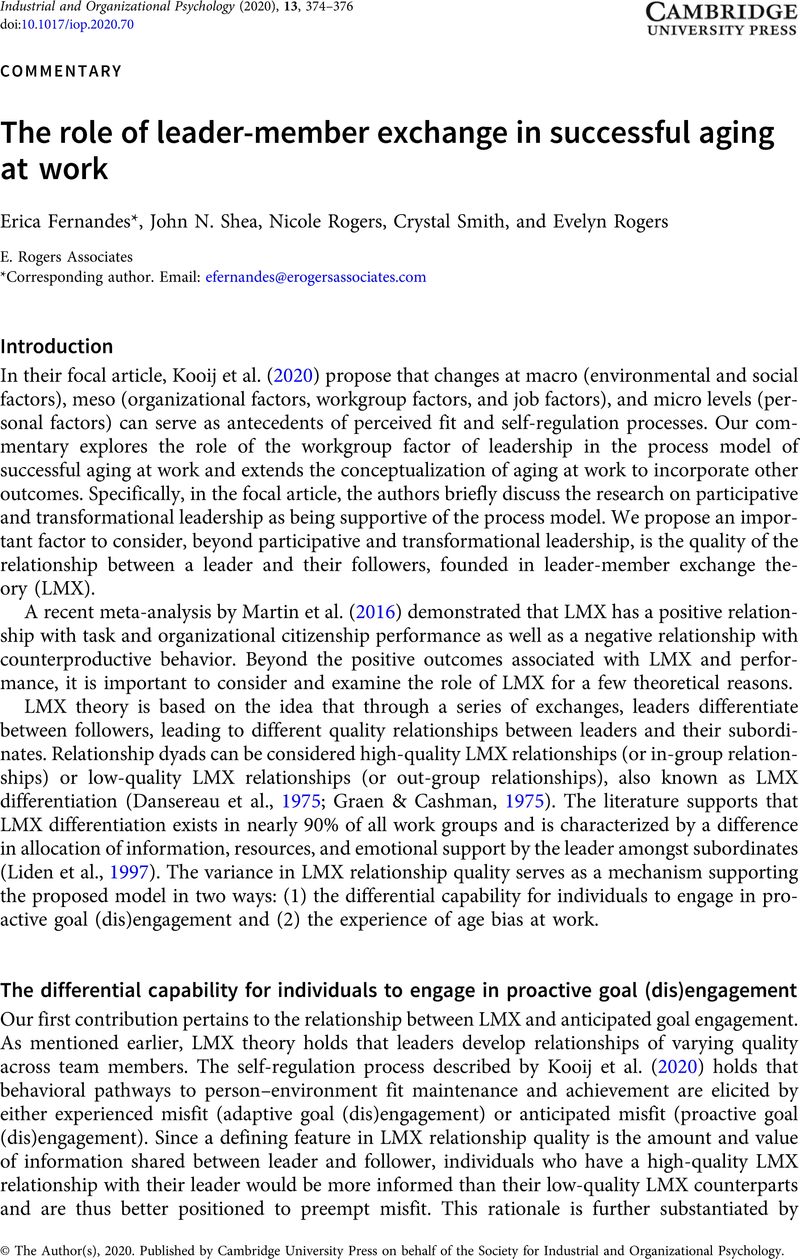No CrossRef data available.
Article contents
The role of leader-member exchange in successful aging at work
Published online by Cambridge University Press: 11 November 2020
Abstract
An abstract is not available for this content so a preview has been provided. Please use the Get access link above for information on how to access this content.

- Type
- Commentaries
- Information
- Copyright
- © The Author(s), 2020. Published by Cambridge University Press on behalf of the Society for Industrial and Organizational Psychology.
References
Anand, S., Hu, J., Liden, R. C., Vidyarthi, P. R. (2011). Leader-member exchange: Recent research findings and prospects for the future. In Bryman, A., Collinson, D., Grint, K., Jackson, B., & Uhl-Bien, M. (Eds.), The sage handbook of leadership (pp. 311–325). Sage.Google Scholar
Chiaburu, D. S., Smith, T. A., Wang, J., & Zimmerman, R. D. (2014). Relative importance of leader influences for subordinates’ proactive behaviors, prosocial behaviors, and task performance: A meta-analysis. Journal of Personnel Psychology, 13(2), 70-86.CrossRefGoogle Scholar
Crant, J. M. (2000). Proactive behavior in organizations. Journal of Management, 26, 435–462.CrossRefGoogle Scholar
Dansereau, F., Graen, G., & Haga, W. J. (1975). A vertical dyad linkage approach to leadership within formal organizations: A longitudinal investigation of the role making process. Organizational Behavior and Human Performance, 13, 46–78.CrossRefGoogle Scholar
Furunes, T., Mykletun, R., Einarsen, S., & Glasø, L. (2015). Do low-quality leader-member relationships matter for subordinates? Evidence from three samples on the validity of the Norwegian LMX scale. Nordic Journal of Working Life Studies, 5(2), 71-87.CrossRefGoogle Scholar
Graen, G., & Cashman, J. (1975). A role-making model of leadership in formal organizations: A developmental approach. In Hunt, J. G. & Larson, L. L. (Eds.), Leadership frontiers. Kent State University Press.Google Scholar
Kooij, D. A. M., Zacher, H., Wang, M., & Heckhausen, J. (2020). Successful aging at work: A process model to guide future research and practice. Industrial and Organizational Psychology: Perspectives on Science and Practice, 13(3), 345–365.Google Scholar
Liden, R. C., Sparrowe, R. T., & Wayne, S. J. (1997). Leader-member exchange theory: The past and potential for the future. In Ferris, G. R. (Ed.), Research in personnel and human resource management (Vol. 15, pp. 47–119). JAI Press.Google Scholar
Martin, R., Guillaume, Y., Thomas, G., Lee, A., & Epitropaki, O. (2016). Leader–member exchange (LMX) and performance: A meta-analytic review. Personnel Psychology, 69, 67–121.CrossRefGoogle Scholar
Van Dam, K., Van Vuuren, T., & Kemps, S. (2017). Sustainable employment: The importance of intrinsically valuable work and an age-supportive climate. The International Journal of Human Resource Management, 28, 2449–2472.CrossRefGoogle Scholar




